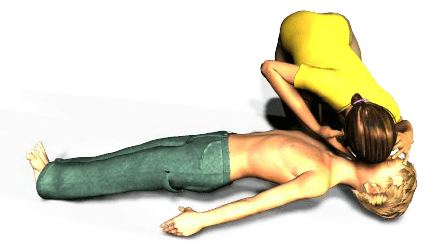Progress
Healthcare Provider BLS Certification | Child Recovery
Rescue Breathing
If the child victim has a pulse but is not breathing, provide rescue breathing at a rate of 1 breath every 3-5 seconds. The breaths should be sufficient to make the chest rise and be delivered over 1 ½ - 2 seconds. Deliver rescue breaths for about 1 minute, then re-assess the victim starting this time with a pulse check.
IMPORTANT:
Be careful not to breathe with too much force or volume. This will cause abdominal distension. The victim’s abdomen will swell and make it difficult to ventilate.

Re-assessment
Starting with a pulse check, you should re-assess the victim after every 5 cycles of CPR (about 2 minutes) or after every 1 minute of rescue breathing. If the victim has no pulse, continue CPR. If the victim has a pulse, check for breathing. If the victim has a pulse but is not breathing, provide 1 minute of rescue breathing and re-assess. If breathing and circulation are present, re-assess the victim every 1-2 minutes.
Recovery Position
If you do not suspect a spinal or cervical injury, place the victim on his or her side with their head resting on their shoulder as illustrated below. This will prevent the victim from aspirating any vomit and allow you to easily monitor for breathing and circulation.